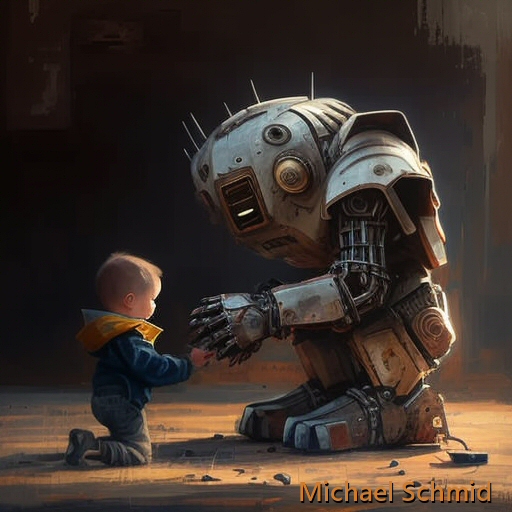Hey there, wonderful souls of the parenting universe!
Do you remember those cherished memories of opening a brand-new toy on a birthday or holiday morning? The eager excitement, the tender joy, and that rush of endless possibilities? Those little playthings weren’t just toys; they were gateways to imagination. Now, imagine our kiddos today, their toys have transformed! They’re now digital, more advanced, and yes, even a bit scary at times. Let me take you down memory lane while we unwrap the AI “toys” of our time.

I generated this image for free in about 30 seconds using Midjourney AI
Do you remember when we were starstruck by our favorite movie stars? Now, let’s introduce some of the tech “stars” that our kids might rave about:
-
- OpenAI’s GPT-4: Think of it as the Shakespeare of the digital realm. Writing, coding, chatting – it’s got the flair!
- Microsoft’s Bing Chat: Imagine a friendly librarian, always ready to help, tucked right into your search engine.
- Google’s Bard: Google’s very own poet, adding colors to the canvas of text.
- DALL-E 2: If Picasso had a digital sibling, this would be it. Transforming words into breathtaking art.
- Midjourney: The new kid on the block, painting pictures so real you could almost touch them.
Now, my dear friends, let’s go on a journey of exploration – the glitter, the gray, and the shadow sides of these digital wonders. And oh! I’ve sprinkled some gems tailored for different age groups that you might find close to your heart.
The Sparkling: Imagine a world where our little ones harness the power of AI to craft stories, design art, and even solve those pesky math problems. It’s like handing them a magical quill or paintbrush, isn’t it? And hey, it’s not just for the kids – we can create our own wonders too!
The Gray Clouds: But as with every magical tale, there’s always a caution. Remember the tales we were told about talking to strangers? In the digital age, we need to share stories of cyber-safety, the art of verification, and the importance of privacy.
The Shadowy Alley: Little minds are beautiful, curious, but sometimes too trusting. They might see all in black and white, unaware of the AI’s gray. It’s up to us to guide them, to ensure they know fact from fiction, and the real value of human touch and emotion.
Btw, purchasing the book below might sprinkle a few cents my way if you feel it calls out to you. Remember, I'm just the messenger; dive into its tales to know if it resonates with your journey. Thanks for the love! ❤️

- For our tiny tots (5-9): Like a delicate bird in the vast sky, guide them close. Check out Common Sense Media (https://www.commonsensemedia.org/) for stories of digital guidance.
- For the budding blossoms (10-14): They’re stretching their wings, aren’t they? Instill tales of cyber-ethics, and the realm of AI. ConnectSafely (https://www.connectsafely.org/) might just be the lantern you seek.
- For our nearly-fledged (15-18): Oh, the horizon they see! While they soar, discuss dreams, responsibilities, and the mysteries of AI. The AI4K12 Initiative (https://ai4k12.org/) could be their guiding star.
Together, with stories old and new, let’s help our young dreamers weave their tapestry in this vast digital cosmos. Do your tales resonate with mine? I’d love to hear. Pour your thoughts below, and let’s embark on more journeys, hand in hand.
With timeless tales and parental love,
Michael
P.S. Do you crave more stories? I might know a magical portal or two. Subscribe, and let’s create new legends.
[Disclaimer: This post contains affiliate links, which means I may receive a small commission if you click a link and purchase something that I have recommended. While clicking these links won’t cost you any extra money, they will help support this site. Thank you for the trust and support!]

